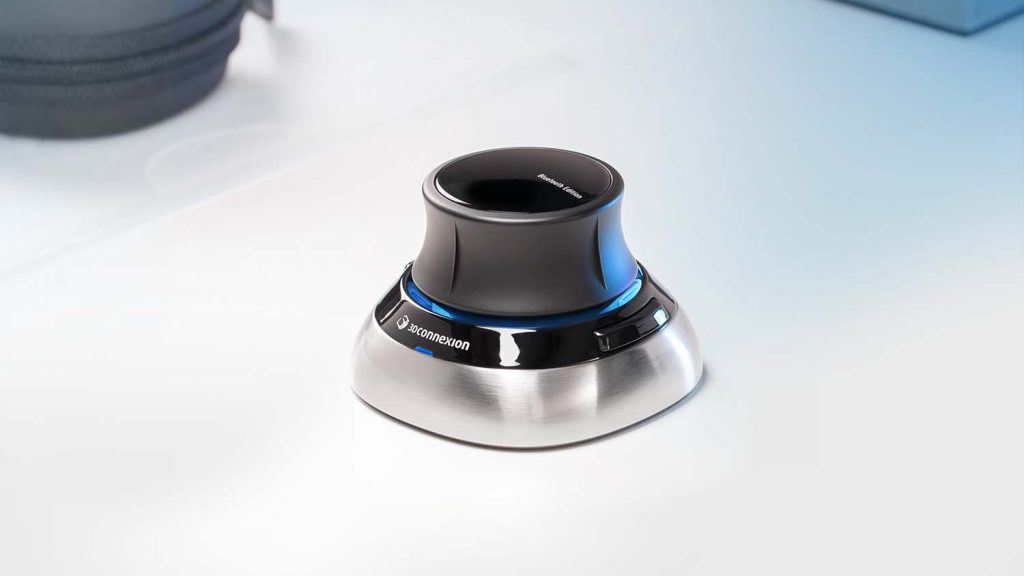The most advanced portable peripheral for controlling your 3D CAD software has been updated with expanded connectivity – but is the SpaceMouse still the go-to option for reliability and ease of use? Lawrence Marks gets his hands on the new Bluetooth-enabled version to find out
I’ve used a 3Dconnexion SpaceMouse at my desk and on the move since 2018. Like most designers, taking it away from me would be like cutting off my left hand – or at least a couple of fingers.
For anyone unacquainted with what 3Dconnexion has achieved, the SpaceMouse is used in your non-dominant hand to navigate 3D space, leaving your usual mouse-wielding hand to do all the selecting and clicking.
Since I was introduced to the smaller, hockey puck-like version of 3Dconnexion’s range, built of black plastic and brushed-steel and with an unmistakable heft to its weighted base, I’ve never looked back and it has never gone wrong.
Despite going wireless over ten years ago, 3Dconnexion has until now stayed true to its Universal Receiver technology. Since almost everything else on my desk has a Bluetooth connection, it’s fair to say that 3Dconnexion has left it late to make the shift.
But with changing times come changing demands. Many designers are on the move once more – whether that involves international trips to meet clients, hot-desking in offices, or taking a laptop home for the weekend. With USB ports on laptops now a luxury, a simple Bluetooth connection can be a game changer.
To meet these needs, 3Dconneexion’s team of engineers have given us the SpaceMouse Wireless Bluetooth Edition. Arriving packaged in a neat, clinical manner, it comes complete with a zipped soft shell travel case, along with a USB-C charging lead and the classic 3Dconnexion Universal Receiver dongle – both of which you can use to connect the SpaceMouse to a workstation should Bluetooth be unavailable.
As soon as the device is out of the packaging, you can see that this thing has the build, component quality, material selection and feel of a decent piece of industrial design. Despite its portability, the SpaceMouse still has enough weight to keep it steady on the desk during use.
The familiar CMF of black, silver and blue is not a million miles from my older desktop model, but it remains modern in its angles and understated when part of the usual desktop furniture.
Link up
To test the set-up process, I plugged the SpaceMouse into my HP workstation, a laptop and an Apple MacBook Air for good measure. Having downloaded 3Dconnexion Home from the website, I was off. Simple. No fuss. Effective.
Individual drivers can be downloaded from 3DConnexion’s website, and the company’s ‘all-in-one’ driver 3DxWare 10 speeds up the process if you’ve a lot of applications to work across.
With 221 applications ready to roll, and the ability to customise shortcuts, it’s as efficient to get started as it is when using your CAD package of choice.
There seem to be endless customisation options for each of your software applications, via the two programmable side buttons on the SpaceMouse Wireless. You can assign your favourite commands, create radial menus and map custom macros to these buttons simply, using the single 3DxWare driver.
It’s on the software side that a lot of 3Dconnexion’s development hours have been focused in order to make its devices easy to use, with a steady stream of updates keeping hardware primed for the latest CAD releases.
I tested this device with an ancient version of Siemens Solid Edge on some design and simulation model prep work, along with current versions of Dassault Systèmes Abaqus/CAE and Siemens Simcenter STAR-CCM+ CFD software. To mix things up, I also used the SpaceMouse with Shapr3D on the Macbook Air.
In all these applications, it just worked – with the MacBook Air, Shapr3D and SpaceMouse combo proving particularly effective given how un-CAD-optimised the MacBook is.
Switching between devices – from desktop to laptop, or even to a colleague’s machine – is as seamless as connecting to any other Bluetooth device in the modern world. Simply select the mouse from your Bluetooth options and, driver install permitting, you are straight into your work.
You can place the mouse wherever you like on your desk or rest it on your knee while trying to work in a cramped train seat. Living without wires – as seen with headphones and all manner of electronics – offers great freedom, and with around one month of battery life, recharging is not a matter of anxiety.
Comfort
As a tool to be used for long periods, the SpaceMouse works very well indeed – a reflection of the experience and dedication that 3Dconnexion puts into its ergonomics engineering. It’s light to manoeuvre and raised fins every 90 degrees give the user enough purchase to push, pull, twist or turn. Resistance is sufficiently light that working with the SpaceMouse never becomes taxing.
These smooth and simple movements transform the way in which you interact with 3D models. Once you have your shortcuts selected, using apps becomes far more intuitive than before. The best way to measure this is by attempting to go back to working without a SpaceMouse. Instantly, you are in a mess of mouse buttons and movements, trying to get the feel for the part or the results set that you are visualising.
The big worry, in fact, is that a wireless SpaceMouse might be easier to misplace or leave behind somewhere – and where would you be without it?
This article first appeared in DEVELOP3D Magazine
DEVELOP3D is a publication dedicated to product design + development, from concept to manufacture and the technologies behind it all.
To receive the physical publication or digital issue free, as well as exclusive news and offers, subscribe to DEVELOP3D Magazine here






